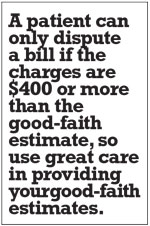 |
|
Have a question for “Coding Commentary”? Tweet it to us at | |
|
Bio |
Beginning this year, Congress enacted Title I, known as the No Surprises Act, which falls under the Consolidated Appropriations Act of 2021. This requires that you patients who are paying out-of-pocket a “good-faith estimate” of costs before you provide the services.
You may think, as a vitreoretinal specialist, you wouldn’t be affected by this legislation. However, the No Surprises Act (NSA) requirements apply to items and services provided to most individuals enrolled in private or commercial health coverage. They include:1
- Employment-based group health plans, both self-insured and fully insured.
- Individual or group health coverage on or outside the federal or state-based exchanges.
- Federal Employee Health Benefit (FEHB) health plans.
- Non-federal governmental plans sponsored by state and local government employers.
- Certain church plans within Internal Revenue Service jurisdiction.
- Student health insurance coverage as defined by Title 45 of the Code of Federal Regulations.2
The act doesn’t pertain to Medicare (Part B or Part C), Indian Health, Veterans Affairs, TRICARE or other federal plans, including Medicaid since it already has regulatory protections against higher medical bills in place. The majority of commercial plans likely fall under the act.
Where it applies to retina specialists
NSA applies in three categories when a person gets the following covered services:
- Emergency services from an out-of-network (OON) provider or emergency facility.
- OON nonemergency services delivered as part of a visit to an in-network facility.
- OON air ambulance services.
Significantly, the first two points might apply to retina services. As a subspecialist, you’ll have referrals from provider networks that you’re not part of. You might also provide emergency services in your local hospital even when you’re not part of the hospital network. Ambulatory surgery centers are also included in the definition, so consider services you provide in your ASC as eligible. ASCs are also responsible for their own NSA notice. For example, their anesthesia providers might be OON.
Other situations in which the NSA is relevant include when the patient either doesn’t have health insurance or does but chooses not to use it, usually because of high copays and/or deductibles.
The art of the good-faith estimate
In any of these scenarios, you as the provider are required to give the patient a good-faith estimate for the services they’re seeking. The Centers for Medicare & Medicaid Services instructs patients accordingly:3
Providers and facilities must give you:
- Your good-faith estimate before an item or service is provided, within certain time frames.
- An itemized list with specific details and expected charges for items and services related to your care.
- Your good-faith estimate in writing (paper or electronic). Note: A provider or facility can discuss the information included in the estimate over the phone or in person if you ask.
- Your estimate in a way that’s accessible to you.
Your estimate should be in writing, even if the patient only asks for a verbal explanation. We also recommend that you have the patient sign and date the itemized estimate. It’s important you give the patient a copy and save a copy to the patient’s file. The arbitrator will want that if there’s a conflict later on.
 |
If you still think the Act doesn’t pertain to you, consider these scenarios:
A patient from out of state calls your office on the recommendation of a friend he’s visiting. He has HMO insurance and you’re out of his network. He’s experiencing flashes and an increase in floaters. Your staff member schedules him for an urgent same-day visit. On exam, you find a superior horseshoe tear in his right eye and recommend urgent laser retinopexy in the office.
Question: Does the NSA apply in this encounter?
Answer: Yes. You must give the patient a written good-faith estimate for the exam and any testing (such as extended ophthalmoscopy or optical coherence tomography), as well as the cost of the operation. The exam and testing notice are provided at check-in, before the services. If laser or other surgery is indicated, that good-faith estimate needs to be given before that service.
An established patient returns for her annual diabetic eye exam. She tells the front desk that she has new insurance, and the annual deductible is $2,000, so she wants to pay cash for her visit. You perform a comprehensive eye exam and, because of scattered microaneurysms, also do fundus photography.
Question: Does the NSA apply here?
Answer: Yes. NSA covers any self-pay patient, either because they’re uninsured or by preference. You must also give this patient a good-faith estimate for the exam and photos before you provide the services.
When disputes arise
Patients can enter the dispute resolution process set up as part of the NSA if the NSA is implicated. CMS defines specific requirements when a patient may dispute a bill for services. They are:4
- When the patient is uninsured or self-pay (that is, has insurance but didn’t use it to pay for the healthcare item or service).
- The medical items or services were provided on or after January 1, 2022.
- The patient has a good-faith estimate from the provider.
- The patient has a bill dated within the last 120 calendar days (about four months).
- The difference between the good-faith estimate and the bill from any single provider or facility is at least $400.
Note the last point: a patient can only dispute a bill if the charges are $400 or more than the good-faith estimate, so use great care in providing your good-faith estimates.
Remember, you’re required to provide an estimate for this class of patients. So, it’s not a good idea to just “not give an estimate” to try to thwart the process.
You can find sample fair estimate forms on the CMS website.5 The NSA doesn’t specify a form, but it does require a process that’s transparent to the patient. Colleagues may have more user-friendly forms.
The major issue with the NSA doesn’t come from your willingness to follow it. The issue will be identifying this small cohort of patients to whom it applies. Be sure your staff members—those in scheduling, check-in and billing, as well as technicians/scribes—are aware of the NSA requirements so you can give patients appropriate estimates. With diligence in your registration process, you can avoid any surprises from the NSA. RS
REFERENCES
1. Centers for Medicare and Medicaid Services. Center for Consumer Information & Insurance Oversight. The No Surprises Act’s Prohibitions on Balancing Billing. Accessed June 23, 2022. Available at: https://www.cms.gov/nosurprises/consumers/understanding-costs-in-advance.
2. Code of Federal Regulations. Title 45, Subtitle A, Subchapter B, Part 147, section 147.145 Student Health Insurance Coverage. Updated May 27, 2022. Accessed June 23, 2022. Available at: https://www.ecfr.gov/current/title-45/subtitle-A/subchapter-B/part-147/section-147.145.
3. CMS. Understanding costs in advance. Updated April 12, 2022. Accessed June 23, 2022. Available at: https://www.cms.gov/nosurprises/consumers/understanding-costs-in-advance.
4. CMS. Medical bill disagreements if you’re uninsured. Updated May 22, 2022. Accessed June 23, 2022. Available at: https://www.cms.gov/nosurprises/consumers/medical-bill-disagreements-if-you-are-uninsured.
5. CMS. Standard notice and consent documents under the No Surprises Act. Accessed June 23, 2022. Available at: https://www.cms.gov/files/document/standard-notice-consent-forms-nonparticipating-providers-emergency-facilities-regarding-consumer.pdf.




